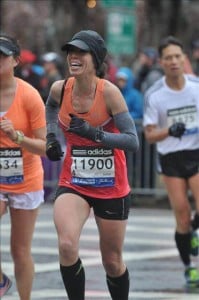Small Changes Can Lead To Big PRs
Enjoy this guest blog from Garmin ambassador Michele Gonzalez. You can read more about her running journey on www.nycrunningmama.com
If you are like me, then when you don’t hit the race times you want, you turn to your training plan and come up with ways to run faster, longer, harder. And that may work. But, as in my case, that’s not always the answer.
I ran a 3:22 marathon in 2007, then 3:21 in 2009. And then had that PR for six years. Six years of working hard in training, but not seeing any drops in my race times. It was frustrating to feel like I was doing everything possible to improve, but that it still wasn’t enough to improve upon my PRs.
About 15 months ago, I decided to change the way I approached training and racing. Rather than get wrapped around the miles or paces I was running (or needed to run), I took a step back and identified the “other” aspects of running – all the things that go into running and racing – that I could improve upon. These are usually the things that are secondary to the training plan, but tweaking just a few things could lead to big PRs.
With the change in my approach, I had my best year of racing – I brought my marathon PR from 3:21 to 3:15 (Boston 2015) and then down to 3:12 (Wineglass).

Here are some of the changes I made.
Mental Strength. As much as I believed I had it, I didn’t. When I look back at previous races, it’s clear that it usually wasn’t my body that quit…it was my mind. Whether it was due to running slower than I hoped or not being ready to push through the pain (which will always come in the later miles of any race you run), my mind would quit – and once that happened, my body followed.
Race Strategy: No matter how well you train, if you start any race significantly faster than goal pace, you will watch your PR run away from you. I would start a race and feel the need to “bank time”: run a bit faster than goal pace so that if/when I slowed later in the race, I would have that extra time to fall back on. These days, I’m much more confident and patient in the race and let my body dictate the pace while easing in to the race.
Strength/Core Work: It’s so easy to get into a routine of “just” running. I often wait until the last moment to run and then have no time to do any strength or core work post-run. Last winter, I aimed at doing 15-20 min of either strength or core on a daily basis. For the first time in years, my entire body felt strong – and that feeling carried over to the later miles on race day. These days, I’d much rather cut a run short by a mile or two to leave myself a small window of time to fit these workouts in.
Easing up on easy days: One of the biggest mistakes I made was going too hard every day. I never had a problem of working hard on the hard days. Not many runners have problem with that. But a lot of runners are like me. I didn’t have the confidence or trust to ease up on the easy days. I was not giving my body the chance to recover from the hard workouts and was preventing myself the chance to improve because I was always tired. These days I am running my easy days 15-45 seconds/mile slower than I was a few years ago. By honoring the easy days, I am rested and ready to run hard on the hard days. Once I made the transition to easier easy days, I almost immediately say my paces begin to fall.
Patience: I think we live in an age where we expect results right now. For years, I didn’t have patience to trust the process and let the race times, mileage and paces happen naturally. I wanted it all to happen immediately. And so I trained at paces that I shouldn’t have been running yet, ran mileage that was higher than my body was ready for and chased race times that I was not capable of running. These days, I focus on the process rather than the endstate. I aim for a strong, successful training cycle. I aim to improve my times as the cycle progresses and make a determination of my ability and race goals at the conclusion. It’s great to have huge goals, but it’s often more realistic to break those goals down into manageable chunks and focus on tackling them piece by piece.
The post Small Changes Can Lead To Big PRs appeared first on Garmin Blog.
Sample Block Quote
Praesent vestibulum congue tellus at fringilla. Curabitur vitae semper sem, eu convallis est. Cras felis nunc commodo loremous convallis vitae interdum non nisl. Maecenas ac est sit amet augue pharetra convallis nec danos.
Sample Paragraph Text
Praesent vestibulum congue tellus at fringilla. Curabitur vitae semper sem, eu convallis est. Cras felis nunc commodo eu convallis vitae interdum non nisl. Maecenas ac est sit amet augue pharetra convallis nec danos dui.
Cras suscipit quam et turpis eleifend vitae malesuada magna congue. Damus id ullamcorper neque. Sed vitae mi a mi pretium aliquet ac sed elitos. Pellentesque nulla eros accumsan quis justo at tincidunt lobortis denimes loremous. Suspendisse vestibulum lectus in lectus volutpat, ut dapibus purus pulvinar. Vestibulum sit amet auctor ipsum.

